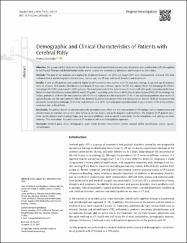| dc.description.abstract | Objective: The purpose of this study was to identify the demographic and clinical characteristics of patients with cerebral palsy (CP) who applied to the Physical Therapy and Rehabilitation Center and to increase the awareness of physicians and therapists on this subject. Methods: The data of 224 patients who applied for treatment between July 2015 and August 2017 were retrospectively reviewed. This data included clinical and demographic characteristics, such as age, sex, CP type, additional disorders, and treatments. Results: A total of 204 patients were analyzed. Eighty-six of the patients were women and 118 were men. Average of age and age of diagnosis were 10, 35 years, 14.5 months. Distribution according to CP types was as follows: spastic 167 (81.8%), diplegic 50 (24.5%), tetraplegic 93 (45.6%), hemiplegic 24 (11.8%), and mixed 14 (6.9%) patients. The functional levels of the patients were first rank with 26% grade 4 according to the Gross Motor Function Classification System (GMFCS) and 27.5% grade 1 according to the Manual Ability Classification System (MACS). Of the etiologic risk factors, premature birth was the most common with 41.1% and asphyxia was the second with 25.4%. In the additional problems observed in CP, speech disorder was the most common with 57.8%, followed by mental retardation 44.6% and epilepsy 32.3%. Overall, 78.9% of the patients had previously received physiotherapy, 43.1% had used orthotics, and 30.9% had undergone musculoskeletal surgery. In total, 27.8% of the orthoses used were foot, ankle orthosis. Conclusion: Precautions should be taken to reduce the perinatal causes, which are the most common in CP etiology, such as improvement and dissemination of neonatal care centers, close follow-up of risky babies, and early diagnosis and treatment. The majority of CP patients constitute spastic diplegic and tetraplegic types, and additional problems, such as speech impairment, mental retardation, and epilepsy are more common. This necessitates the continuation of CP treatment with a multidisciplinary approach. Keywords: Cerebral palsy, clinic, demographic, gross motor function classification system, manual ability classification system, spastic, rehabilitation | en_US |



















